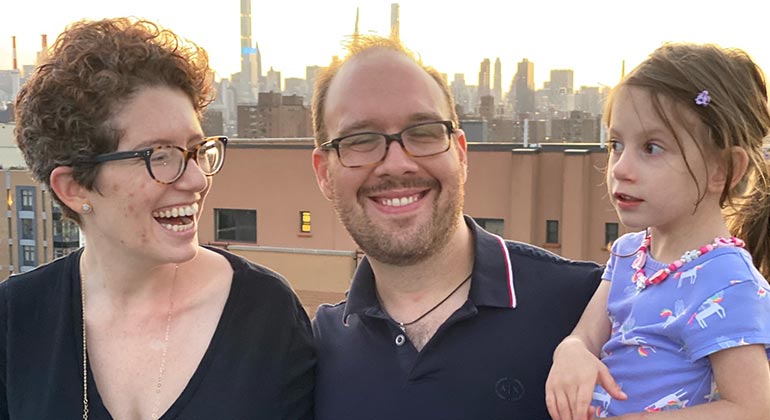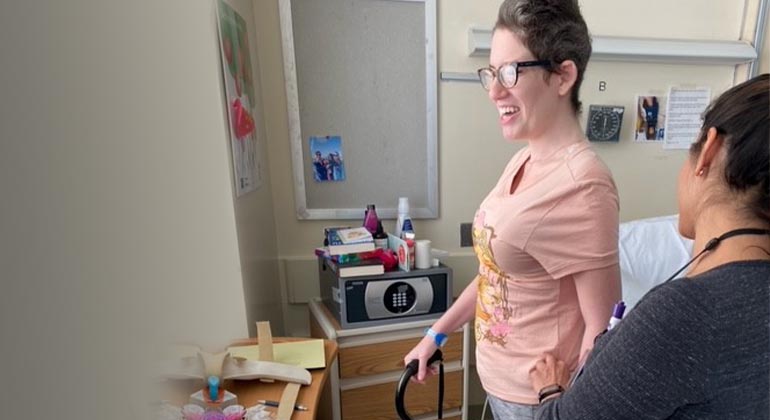
Recovering 33-Year-Old Stroke Patient Raises Awareness That Young People Have Strokes, too.
On December 1, 2019, 33-year-old Katie Adler was at her home in Astoria, Queens, cooking dinner with her husband and a friend when the left side of her body suddenly went numb, and her speech became slurred. “I knew something was wrong,” Katie recalls.
She went to the emergency room at Mount Sinai Queens and underwent a CT scan. Although the scan showed nothing suspicious, she was admitted overnight. Katie had an MRI the next day, and that is when a blood clot was discovered. She was immediately transferred to The Mount Sinai Hospital, where Christopher Kellner, MD, Assistant Professor of Neurosurgery and Director of the Mount Sinai Intracerebral Hemorrhage Program, performed a craniectomy to make space for her brain swelling and then removed the large blood clot blocking a major vein in her brain.
“Kathleen had a rare case of stroke called a cerebral venous sinus thrombosis, caused by a blood clot blocking the veins of the brain. Because of new technology and techniques, we have recently been able to remove these blood clots safely and to effectively treat this disease in combination with anticoagulation medicine,” Dr. Kellner says.
Katie spent the next two weeks in the Neurosciences Intensive Care Unit—though she has no memory of that period—until she was transferred to the neurosurgery step-down unit and then inpatient rehabilitation. In February, she underwent a second surgery with Dr. Kellner, this time a cranioplasty to reconstruct the shape of the skull with a plastic implant.
For four months, Katie worked closely with brain injury rehabilitation specialists Caroline Lim, OT, and Nehal Patel, PT, to regain her motor functions after her stroke. Simple things such as sitting upright and moving parts of her body seemed almost impossible, but once she was discharged at the very start of the COVID-19 pandemic, she could stand on her own and walk a few steps. Throughout the pandemic, Mount Sinai staff visited Katie to provide services at her home. First, nurses visited for a few weeks, then physical therapists came to perform outpatient therapy before facilities reopened in May.
By early October, 2020, Katie was able to walk with a cane, using a transport chair for longer distances. And although she is still working on regaining strength in her left arm, is grateful for how far she has come. “I literally went from not being able to hold up my head, to being able to walk,” she says.
“I was very thankful to be in New York City, and mainly for Dr. Kellner. I knew I was in good hands. He’s very, very personable and had a great bedside manner. I was very fortunate to have him,” Katie adds. “Dr. Kellner saved my life, and the therapists made it a life worth living.”
Dr. Kellner says, “It has really been an honor to get to know Katie and her husband, Zack, throughout Katie’s treatment and recovery. Their compassion and humor throughout this process have been really inspiring.”
Since her stroke, Katie has been doing her part to raise awareness of the fact that younger people are susceptible, too. “Strokes are not just for old people. I think everyone thinks that only old people have strokes,” Katie says. “There are a lot of unknowns. I still have no idea why I had a stroke.”
